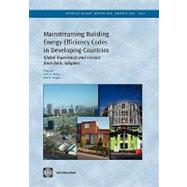
Note: Supplemental materials are not guaranteed with Rental or Used book purchases.
Purchase Benefits
What is included with this book?
| Foreword | p. viii |
| Acknowledgments | p. x |
| Acronyms and Abbreviations | p. xi |
| Definitions | p. xv |
| Executive Summary | p. xx |
| Key Messages | p. xx |
| Main Findings and Conclusions | p. xxi |
| Recommendations and International Assistance Strategies | p. xxvii |
| Introduction | p. 1 |
| Energy Use in Residential, Commercial, and Public-Service Buildings | p. 1 |
| Energy-Savings Opportunities in Buildings | p. 4 |
| Market Barriers and Building Energy Efficiency Codes | p. 7 |
| The Role of Incentives | p. 11 |
| Key Challenges to Implementing BEECs in Developing Countries | p. 13 |
| Building Energy Efficiency Codes and Elements of Compliance | p. 16 |
| The Nature of Building Energy Efficiency Codes and Compliance Approaches | p. 16 |
| Development and Implementation of BEECs | p. 19 |
| Enforcement of BEECs | p. 26 |
| Compliance Approaches and Enforcement Interactions | p. 27 |
| Toward Low-Energy and Green Buildings | p. 30 |
| Global Status of Building Energy Efficiency Codes and Compliance | p. 34 |
| Status Quo of BEECs in Developing Countries and Economies in Transition | p. 34 |
| Track Record of BEEC Compliance and Enforcement | p. 40 |
| European and U.S. Experiences in Development and Implementation of BEECs | p. 43 |
| European Union: Early Efforts and Enforcement Approaches in Selected Countries | p. 43 |
| Toward Regional Harmonization: the EU Energy Performance in Buildings Directive | p. 50 |
| United States: State-Level Adoption of BEECs | p. 52 |
| Compliance and Enforcement of BEECs in the United States | p. 57 |
| Lessons Learned from the Pioneers | p. 66 |
| Experiences from Early Adopters of BEECs in Developing Countries | p. 70 |
| Summary of Case Studies: China, Egypt, India, and Mexico | p. 70 |
| Urbanization and Energy Use in the Buildings in the Four Countries | p. 71 |
| Development and Implementation of BEECs | p. 72 |
| Lessons Learned from the Early Adopters | p. 83 |
| Mainstreaming BEECs in Developing Countries and International Assistance Strategies | p. 85 |
| Expand and Strengthen the Political Support for Energy Efficiency | p. 86 |
| Improve the Effectiveness of Government Supervision of the Building Construction Sector | p. 86 |
| Develop Technical and Engineering Capacity of the Supply Chain | p. 87 |
| Bridge the Gap in Incremental Cost Financing | p. 89 |
| Appendixes | p. 91 |
| Case Study: Implementing Building Energy Efficiency Codes in China | p. 93 |
| Case Study: Building Energy Efficiency Codes in Egypt | p. 111 |
| Case Study: Toward Implementation of the Energy Conservation Building Code in India | p. 125 |
| Case Study: Mexico-Breaking Building Energy Efficiency Grounds with a National Low-Income Housing Program | p. 144 |
| Case Study: BEEC Implementation in the U.S. State of California | p. 163 |
| Case Study: BEECs in Selected Countries in Asia, Latin America, Eastern Europe, Middle East and Africa | p. 176 |
| Voluntary Low-Energy/Green Building Schemes | p. 179 |
| References | p. 182 |
| Tables | |
| Incentives for Adopting or Exceeding the Requirements of BEECs | p. 12 |
| Institutional Options for Enforcement of Building Codes, Including BEECs | p. 29 |
| Regional Status of BEECs in Low- and Middle-Income Countries* | p. 36 |
| Experience with BEEC Compliance around the World | p. 41 |
| Main Features of Building Permit Procedures in Selected European Countries | p. 45 |
| Public- and Private-Sector Roles in Building Control in Selected European Countries | p. 46 |
| Enforcement Models for BEEC Control in Selected European Countries | p. 46 |
| Instruments for BEEC Enforcement | p. 48 |
| Extent of Compliance with BEECs and Underlying Problems | p. 49 |
| EPBD Requirements to Be Implemented in Each EU Member State | p. 51 |
| Code Compliance Rates for Residential Buildings in U.S. States, 2005 | p. 57 |
| California-Summary of Building Measure Noncompliance Estimates | p. 58 |
| Basic Country Data-China, Egypt, India, and Mexico | p. 71 |
| BEECs in China, Egypt, India, and Mexico | p. 75 |
| Conditions for Implementation of BEECs | p. 78 |
| Table of Contents provided by Ingram. All Rights Reserved. |
The New copy of this book will include any supplemental materials advertised. Please check the title of the book to determine if it should include any access cards, study guides, lab manuals, CDs, etc.
The Used, Rental and eBook copies of this book are not guaranteed to include any supplemental materials. Typically, only the book itself is included. This is true even if the title states it includes any access cards, study guides, lab manuals, CDs, etc.